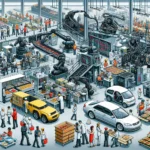Are you preparing for the IELTS Reading test? Look no further! In this comprehensive practice test, we’ll explore the fascinating topic of digital transformation and its impact on workplace dynamics. This test is designed to mirror the actual IELTS Reading exam, featuring three passages of increasing difficulty and a variety of question types. Let’s dive in and sharpen your reading skills while learning about this crucial aspect of modern business.
 Digital transformation in the workplace
Digital transformation in the workplace
Passage 1 – Easy Text
The Digital Revolution in the Workplace
The digital revolution has profoundly transformed the way we work, communicate, and collaborate in the modern workplace. From small startups to large multinational corporations, businesses across all sectors are embracing digital technologies to streamline operations, enhance productivity, and stay competitive in an increasingly global market.
One of the most significant changes brought about by digital transformation is the shift towards remote work. With the advent of cloud computing, video conferencing, and project management tools, employees can now work from virtually anywhere in the world. This flexibility has not only improved work-life balance for many professionals but has also allowed companies to tap into a global talent pool.
Artificial intelligence (AI) and machine learning are also playing a crucial role in reshaping workplace dynamics. These technologies are automating routine tasks, allowing employees to focus on more strategic and creative aspects of their jobs. For instance, AI-powered chatbots are handling customer inquiries, while data analytics tools are providing valuable insights for decision-making.
The rise of digital platforms has also revolutionized communication within organizations. Instant messaging apps, collaboration software, and internal social networks have replaced traditional methods of information sharing, fostering a more open and transparent work environment. This shift has led to flatter organizational structures and more agile decision-making processes.
However, the digital transformation of the workplace is not without challenges. Cybersecurity concerns have become more pressing as companies increasingly rely on digital infrastructure. Additionally, the rapid pace of technological change requires employees to continuously update their skills to remain relevant in the job market.
Despite these challenges, the benefits of digital transformation in the workplace are undeniable. Companies that successfully navigate this digital landscape are likely to see increased efficiency, innovation, and competitiveness in the years to come.
Questions 1-7
Do the following statements agree with the information given in the passage? Write
TRUE if the statement agrees with the information
FALSE if the statement contradicts the information
NOT GIVEN if there is no information on this
- Digital transformation affects only large multinational corporations.
- Remote work has become more common due to digital technologies.
- Artificial intelligence is completely replacing human workers in most industries.
- Digital platforms have made organizational communication more open and transparent.
- Cybersecurity is not a concern for digitally transformed workplaces.
- Employees need to continuously update their skills in the digital age.
- All companies have successfully implemented digital transformation strategies.
Questions 8-10
Complete the sentences below. Choose NO MORE THAN TWO WORDS from the passage for each answer.
- Cloud computing and video conferencing tools have allowed companies to access a .
- AI-powered ___ are being used to handle customer inquiries in many businesses.
- The digital transformation has led to ___ organizational structures in many companies.
Passage 2 – Medium Text
The Impact of Digital Transformation on Organizational Culture
The pervasive influence of digital transformation extends far beyond the mere adoption of new technologies; it is fundamentally reshaping organizational culture and the very essence of how businesses operate. This shift is not just about implementing new software or upgrading hardware; it’s about fostering a mindset that embraces innovation, agility, and continuous learning.
One of the most significant cultural changes brought about by digital transformation is the democratization of information. In traditional hierarchical structures, information often flowed from top to bottom, with decision-making power concentrated at the upper levels of management. However, digital platforms and tools have disrupted this model, enabling a more open flow of information across all levels of the organization. This transparency has led to more inclusive decision-making processes and has empowered employees at all levels to contribute ideas and insights.
The digital era has also ushered in a culture of experimentation and risk-taking. With the ability to collect and analyze vast amounts of data, companies can now make more informed decisions and test new ideas quickly and cost-effectively. This data-driven approach has encouraged a “fail fast, learn faster” mentality, where mistakes are viewed as valuable learning opportunities rather than failures to be avoided at all costs.
Furthermore, digital transformation has blurred the lines between different departments and roles within organizations. Cross-functional collaboration has become the norm, with employees from diverse backgrounds working together on projects that span traditional departmental boundaries. This interdisciplinary approach has fostered creativity and innovation, as different perspectives and skill sets are brought together to solve complex problems.
The concept of lifelong learning has also gained prominence in the digitally transformed workplace. With technology evolving at an unprecedented pace, employees are expected to continuously update their skills and knowledge. Many organizations are investing heavily in training programs and e-learning platforms to ensure their workforce remains adaptable and competitive in the digital age.
However, this cultural shift is not without its challenges. Some employees may resist change, feeling threatened by new technologies or overwhelmed by the pace of transformation. Leaders must navigate these concerns carefully, providing support and guidance to help their teams adapt to the new digital landscape.
Despite these challenges, the cultural changes brought about by digital transformation are largely positive. Organizations that successfully embrace this new culture of innovation, collaboration, and continuous learning are better positioned to thrive in an increasingly competitive and rapidly changing business environment.
Questions 11-15
Choose the correct letter, A, B, C, or D.
-
According to the passage, digital transformation is primarily about:
A) Upgrading hardware and software
B) Changing organizational mindset
C) Reducing the workforce
D) Increasing profits -
The democratization of information in organizations has led to:
A) More centralized decision-making
B) Reduced transparency
C) More inclusive decision-making processes
D) Increased hierarchical structures -
The “fail fast, learn faster” mentality encourages:
A) Avoiding mistakes at all costs
B) Punishing employees for errors
C) Viewing mistakes as learning opportunities
D) Making decisions without data -
Cross-functional collaboration in digitally transformed organizations:
A) Decreases creativity
B) Promotes innovation
C) Reinforces departmental boundaries
D) Reduces efficiency -
The concept of lifelong learning in the digital workplace:
A) Is considered unnecessary
B) Only applies to senior management
C) Is essential for maintaining competitiveness
D) Decreases employee productivity
Questions 16-20
Complete the summary below. Choose NO MORE THAN TWO WORDS from the passage for each answer.
Digital transformation is reshaping organizational culture by promoting (16) and continuous learning. The (17) of information has led to more inclusive decision-making processes. A culture of experimentation and (18) has emerged, encouraged by data-driven approaches. (19) collaboration has become common, fostering creativity and innovation. The concept of (20) ___ has gained importance as employees need to constantly update their skills in the rapidly evolving digital landscape.
Passage 3 – Hard Text
The Ethical Implications of Digital Transformation in the Workplace
The inexorable march of digital transformation in the workplace has undoubtedly brought about numerous benefits, from increased efficiency to enhanced collaboration. However, this technological revolution also raises a host of ethical quandaries that organizations must grapple with as they navigate the new digital landscape. These ethical considerations span a wide range of issues, from data privacy and algorithmic bias to the potential displacement of human workers by automation.
One of the most pressing ethical concerns in the digitally transformed workplace is the collection and use of employee data. As organizations increasingly rely on data analytics to inform decision-making, they are amassing vast amounts of information about their employees’ behaviors, preferences, and performance. While this data can be used to optimize workflows and improve employee experiences, it also raises significant privacy concerns. The line between legitimate performance monitoring and invasive surveillance is often blurred, and organizations must carefully balance their need for data with their employees’ right to privacy.
Moreover, the use of artificial intelligence and machine learning algorithms in workplace decision-making processes has raised concerns about fairness and transparency. These algorithms, which are often used in hiring, performance evaluations, and promotions, can perpetuate or even exacerbate existing biases if not carefully designed and monitored. The “black box” nature of many AI systems makes it difficult to understand how decisions are made, potentially leading to discriminatory outcomes that are hard to detect and rectify.
The rapid pace of automation and the potential displacement of human workers by machines is another ethical challenge that organizations must address. While automation can lead to increased productivity and the creation of new, high-skilled jobs, it also has the potential to cause significant disruption in the labor market. Organizations have an ethical responsibility to consider the societal impact of their automation strategies and to invest in reskilling and upskilling programs to help their workforce adapt to the changing job landscape.
Furthermore, the digital transformation has blurred the boundaries between work and personal life, raising questions about work-life balance and employee well-being. The ability to be constantly connected through digital devices has led to an “always-on” culture in many organizations, potentially contributing to stress, burnout, and mental health issues among employees. Employers must consider their ethical obligation to promote a healthy work environment, even in the context of remote and digitally-enabled work.
The globalization of work enabled by digital technologies also presents ethical challenges related to labor standards and cultural differences. Organizations that leverage global talent pools through remote work arrangements must navigate complex issues related to fair compensation, working conditions, and cultural sensitivity across different regions and legal jurisdictions.
Addressing these ethical implications requires a multi-faceted approach. Organizations need to develop comprehensive ethical frameworks that guide their use of digital technologies in the workplace. This may involve creating new roles, such as Chief Ethics Officers, to oversee the ethical implications of digital initiatives. Additionally, there is a growing need for transparency and accountability in the development and deployment of workplace technologies.
Regulatory bodies and governments also have a role to play in establishing guidelines and legislation to protect workers’ rights in the digital age. This may include updating labor laws to address the challenges of the gig economy, implementing stricter data protection regulations, and mandating transparency in algorithmic decision-making processes.
Ultimately, navigating the ethical implications of digital transformation in the workplace requires a delicate balance between leveraging the benefits of new technologies and upholding fundamental human values and rights. Organizations that successfully navigate these ethical challenges will not only create more sustainable and responsible business models but will also build trust with their employees and stakeholders, positioning themselves for long-term success in the digital era.
Questions 21-26
Complete the sentences below. Choose NO MORE THAN TWO WORDS AND/OR A NUMBER from the passage for each answer.
- The collection of employee data raises significant ___ concerns in the digitally transformed workplace.
- The use of AI in workplace decision-making processes has raised concerns about fairness and ___.
- Organizations have an ethical responsibility to invest in ___ programs to help their workforce adapt to automation.
- The “always-on” culture enabled by digital devices can contribute to ___ among employees.
- The ___ of work enabled by digital technologies presents ethical challenges related to labor standards across different regions.
- Some organizations are creating new roles, such as ___, to oversee the ethical implications of digital initiatives.
Questions 27-30
Choose FOUR letters, A-G. Which FOUR of the following are mentioned in the passage as ethical challenges of digital transformation in the workplace?
A) Employee data privacy
B) Environmental impact
C) Algorithmic bias in decision-making
D) Cybersecurity threats
E) Displacement of workers by automation
F) Work-life balance issues
G) Cultural differences in global work arrangements
Questions 31-35
Do the following statements agree with the claims of the writer in the passage? Write
YES if the statement agrees with the claims of the writer
NO if the statement contradicts the claims of the writer
NOT GIVEN if it is impossible to say what the writer thinks about this
- The benefits of digital transformation in the workplace outweigh the ethical concerns.
- Organizations should prioritize data collection over employee privacy.
- AI algorithms used in workplace decision-making are always fair and unbiased.
- Governments have a role in establishing guidelines to protect workers’ rights in the digital age.
- Organizations that successfully address ethical challenges will build trust with their employees and stakeholders.
Answer Key
Passage 1
- FALSE
- TRUE
- FALSE
- TRUE
- FALSE
- TRUE
- NOT GIVEN
- global talent
- chatbots
- flatter
Passage 2
- B
- C
- C
- B
- C
- innovation
- democratization
- risk-taking
- Cross-functional
- lifelong learning
Passage 3
- privacy
- transparency
- reskilling
- burnout
- globalization
- Chief Ethics Officers
- A, C, E, F
- privacy
- transparency
- reskilling
- NOT GIVEN
- NO
- NO
- YES
- YES
By practicing with this IELTS Reading test on digital transformation in the workplace, you’ve not only honed your reading skills but also gained valuable insights into this important topic. Remember to apply the strategies you’ve learned here to other IELTS Reading passages. Good luck with your IELTS preparation!
For more IELTS practice materials and tips, check out our related articles on how remote work is changing global business practices and the influence of digital technology on modern communication.


